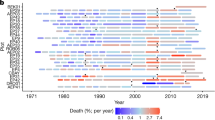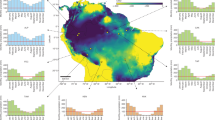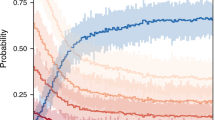Abstract
The projected responses of forest ecosystems to warming and drying associated with twenty-first-century climate change vary widely from resiliency to widespread tree mortality1,2,3. Current vegetation models lack the ability to account for mortality of overstorey trees during extreme drought owing to uncertainties in mechanisms and thresholds causing mortality4,5. Here we assess the causes of tree mortality, using field measurements of branch hydraulic conductivity during ongoing mortality in Populus tremuloides in the southwestern United States and a detailed plant hydraulics model. We identify a lethal plant water stress threshold that corresponds with a loss of vascular transport capacity from air entry into the xylem. We then use this hydraulic-based threshold to simulate forest dieback during historical drought, and compare predictions against three independent mortality data sets. The hydraulic threshold predicted with 75% accuracy regional patterns of tree mortality as found in field plots and mortality maps derived from Landsat imagery. In a high-emissions scenario, climate models project that drought stress will exceed the observed mortality threshold in the southwestern United States by the 2050s. Our approach provides a powerful and tractable way of incorporating tree mortality into vegetation models to resolve uncertainty over the fate of forest ecosystems in a changing climate.
This is a preview of subscription content, access via your institution
Access options
Subscribe to this journal
Receive 12 print issues and online access
$259.00 per year
only $21.58 per issue
Buy this article
- Purchase on Springer Link
- Instant access to full article PDF
Prices may be subject to local taxes which are calculated during checkout




Similar content being viewed by others
References
Cox, P. M. et al. Amazonian forest dieback under climate-carbon cycle projections for the 21st century. Theor. Appl. Clim. 78, 137–156 (2004).
Scholze, M., Knorr, W., Arnell, N. W. & Prentice, I. C. A climate-change risk analysis for world ecosystems. Proc. Natl Acad. Sci. USA 103, 13116–13120 (2006).
Huntingford, C. et al. Simulated resilience of tropical rainforests to CO2-induced climate change. Nature Geosci. 6, 268–273 (2013).
McDowell, N. G. et al. The interdependence of mechanisms underlying climate-driven vegetation mortality. Trends Ecol. Evol. 26, 523–532 (2011).
Powell, T. L. et al. Confronting model predictions of carbon fluxes with measurements of Amazon forests subjected to experimental drought. New Phytol. 200, 350–365 (2013).
Bonan, G. B. Forests and climate change: Forcings, feedbacks, and the climate benefits of forests. Science 320, 1444–1449 (2008).
Keenan, T. F. et al. Increase in forest water-use efficiency as atmospheric carbon dioxide concentrations rise. Nature 499, 324–327 (2013).
Allen, C. D. et al. A global overview of drought and heat-induced tree mortality reveals emerging climate change risks for forests. Forest Ecol. Manage. 259, 660–684 (2010).
Stocker, T. F. et al. (eds) Climate Change 2013: The Physical Science Basis (IPCC, Cambridge Univ. Press, 2013).
Ponce-Campos, G. E. et al. Ecosystem resilience despite large-scale altered hydroclimatic conditions. Nature 494, 349–352 (2013).
Zhao, M. & Running, S. W. Drought-induced reduction in global terrestrial net primary production from 2000 through 2009. Science 329, 940–943 (2010).
Ma, Z. et al. Regional drought-induced reduction in the biomass carbon sink of Canada’s boreal forests. Proc. Natl Acad. Sci. USA 109, 2423–2427 (2012).
Phillips, O. L. et al. Drought-mortality relationships for tropical forests. New Phytol. 187, 631–646 (2010).
van Mantgem, P. J. et al. Widespread increase of tree mortality rates in the Western United States. Science 323, 521–524 (2009).
Friend, A. D. et al. Carbon residence time dominates uncertainty in terrestrial vegetation responses to future climate and atmospheric CO2 . Proc. Natl Acad. Sci. USA 11, 3280–3285 (2014).
Anderegg, W. R. L., Berry, J. A. & Field, C. B. Linking definitions, mechanisms, and modeling of drought-induced tree death. Trends Plant Sci. 17, 693–700 (2012).
Sala, A., Piper, F. & Hoch, G. Physiological mechanisms of drought-induced tree mortality are far from being resolved. New Phytol. 186, 274–281 (2010).
Hoffmann, W. A., Marchin, R. M., Abit, P. & Lau, O. L. Hydraulic failure and tree dieback are associated with high wood density in a temperate forest under extreme drought. Glob. Change Biol. 17, 2731–2742 (2011).
Urli, M. et al. Xylem embolism threshold for catastrophic hydraulic failure in angiosperm trees. Tree Phys. 33, 672–683 (2013).
Anderegg, W. R. L. et al. Drought’s legacy: multiyear hydraulic deterioration underlies widespread aspen forest die-off and portends increased future risk. Glob. Change Biol. 19, 1188–1196 (2013).
Sperry, J. S., Adler, F. R., Campbell, G. S. & Comstock, J. P. Limitation of plant water use by rhizosphere and xylem conductance: Results from a model. Plant Cell Environ. 21, 347–359 (1998).
Flint, L. E., Flint, A. L., Thorne, J. H. & Boynton, R. Fine-scale hydrologic modeling for regional landscape applications: The California Basin Characterization Model development and performance. Ecol. Process. 2, 1–21 (2013).
Rehfeldt, G. E., Ferguson, D. E. & Crookston, N. L. Aspen, climate, and sudden decline in western USA. Forest Ecol. Manage. 258, 2353–2364 (2009).
Stephenson, N. Actual evapotranspiration and deficit: Biologically meaningful correlates of vegetation distribution across spatial scales. J. Biogeogr. 25, 855–870 (1998).
Muggeo, V. M. Estimating regression models with unknown break-points. Stat. Med. 22, 3055–3071 (2003).
McDowell, N. G. et al. Evaluating theories of drought-induced vegetation mortality using a multimodel—experiment framework. New Phytol. 200, 304–321 (2013).
Park Williams, A. et al. Temperature as a potent driver of regional forest drought stress and tree mortality. Nature Clim. Change 3, 292–297 (2013).
Choat, B. et al. Global convergence in the vulnerability of forests to drought. Nature 491, 752–755 (2012).
Sperry, J. S., Donnelly, J. R. & Tyree, M. T. A method for measuring hydraulic conductivity and embolism in xylem. Plant Cell Environ. 11, 35–40 (1988).
Huang, C-Y. & Anderegg, W. R. L. Large drought-induced aboveground live biomass losses in southern Rocky Mountain aspen forests. Glob. Change Biol. 18, 1016–1027 (2012).
Acknowledgements
W.R.L.A. thanks the NSF DDIG grant for research funding and equipment. W.R.L.A. was supported in part by the NOAA Climate and Global Change Postdoctoral Fellowship program and an award from the Department of Energy (DOE) Office of Science Graduate Fellowship Program (DOE SCGF). C-y.H. was sponsored by the Ministry of Science and Technology of Taiwan and National Taiwan University. F.W.D. was supported in part by the National Science Foundation Macrosystems Biology Program, NSF no. EF-1065864. J.A.B. and C.B.F. were supported by the Carnegie Institution for Science. We acknowledge the World Climate Research Programme’s Working Group on Coupled Modelling, which is responsible for CMIP, and we thank the climate modelling groups (listed in Methods of this paper) for producing and making available their model output. For CMIP the US Department of Energy’s Program for Climate Model Diagnosis and Intercomparison provides coordinating support and led development of software infrastructure in partnership with the Global Organization for Earth System Science Portals.
Author information
Authors and Affiliations
Contributions
W.R.L.A., J.A.B. and C.B.F. conceived the experiment. W.R.L.A. collected the data and W.R.L.A. and A.F. ran the models. C-y.H., L.F., F.W.D. and J.S.S. contributed new analytic tools. W.R.L.A. wrote the paper with all authors adding revisions.
Corresponding author
Ethics declarations
Competing interests
The authors declare no competing financial interests.
Supplementary information
Supplementary Information
Supplementary Information (PDF 1311 kb)
Rights and permissions
About this article
Cite this article
Anderegg, W., Flint, A., Huang, Cy. et al. Tree mortality predicted from drought-induced vascular damage. Nature Geosci 8, 367–371 (2015). https://doi.org/10.1038/ngeo2400
Received:
Accepted:
Published:
Issue Date:
DOI: https://doi.org/10.1038/ngeo2400
This article is cited by
-
Drought-adapted leaves are produced even when more water is available in dry tropical forest
Journal of Plant Research (2024)
-
Proline concentrations in seedlings of woody plants change with drought stress duration and are mediated by seed characteristics: a meta-analysis
Scientific Reports (2023)
-
Elevation-dependent tree growth response to recent warming and drought on eastern Tibetan Plateau
Climatic Change (2023)
-
Consistent responses to moisture stress despite diverse growth forms within mountain fynbos communities
Oecologia (2023)
-
Enhanced habitat loss of the Himalayan endemic flora driven by warming-forced upslope tree expansion
Nature Ecology & Evolution (2022)



